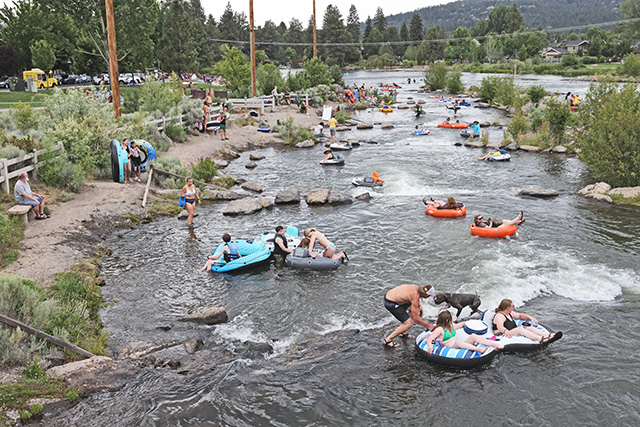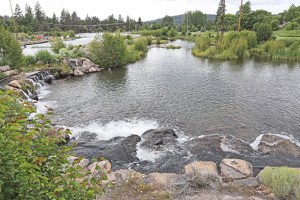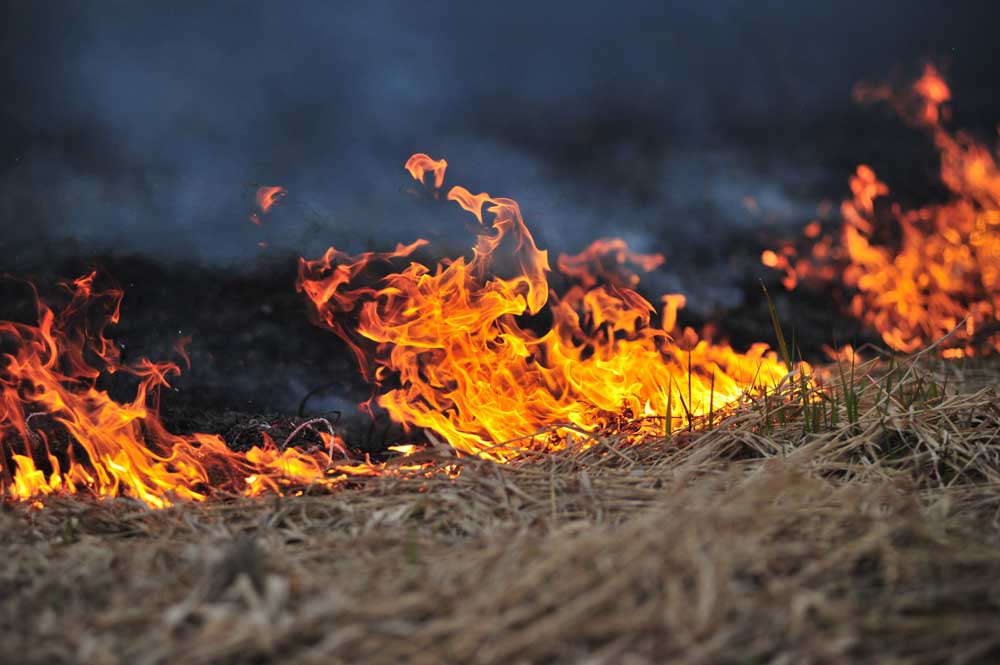After 10 years of use, Bend Whitewater Park needs repairs
Published 11:03 pm Thursday, June 26, 2025

- People enjoy the fish passage channel at the Whitewater Park in Bend. 06/24/25 (Dean Guernsey/The Bulletin)
A recreation engineering team has recommended structural fixes and repairs to prevent hazards and increase use at Bend Whitewater Park.
The park opened 10 years ago, and after years of use, its features need to be refurbished, according to the Bend Park & Recreation District. The district hired the engineering team in 2024 to assess current conditions at the park.
The park was built to replace the Colorado Avenue Dam, which impeded recreation on the river and fish passage. Instead of the dam, which could be dangerous for people and disruptive for fish, the river channels are given over to wildlife, fish passage, floaters, paddlers and surfers. Over 250,000 people float the river in a season, not to mention the surfers and kayakers who ride the waves.
The engineering firm hired by the park district, Recreation Engineering & Planning, Inc., listed dozens of potential improvements in its report on the whitewater park’s conditions and recommendations. Many of these improvements are to make sure the park is safer for recreational use. A teenager died while surfing the standing wave in 2022.
“The importance of the whitewater park is really multi-faceted. I think a lot of people see obviously the recreational value to both the citizens of Bend and visitors,” said Ian Isaacson, landscape architect and project manager for the park district. “We see the ecological uplift from the creation of that third channel, the habitat channel, we have ospreys nesting every year down there and just seeing the wildlife that are reusing the stretch of river has been really important.”
In the summer months, the fish passage channel is used by floaters, who can become trapped in an eddy where it is too deep to touch the bottom, according to the report. The left bank has eroded since it has been used for river access while not being designed for it. The channel should also be widened to allow for heavier water flow, according to the report. An Americans with Disabilities Act-compliant trail should be provided along the left bank. The river access point upstream of the Colorado Avenue bridge should be replaced with an access point that can better handle the amount of recreational use it will get.

Surfers utilize the standing wave in the whitewater channel at the Whitewater Park in Bend. (Dean Guernsey/The Bulletin)
The waves in the whitewater channel have scouring, where material from the riverbed has eroded away, structural issues and areas where people’s feet can be trapped. For several of the waves, recommended repairs include reconstruction of large sections to make sure there isn’t a significant drop in the water level. The pools in the channel need to have scour holes filled, have banks secured and dislodged boulders removed.
The island between the whitewater and fish passage channels needs to be widened to ensure it is stable in future, according to the report. The downstream end also may be restructured to prevent tubers from ending up in a deep eddy.
Pneumatic gates at the head of the channels control the upstream water level for the marsh to protect habitat for the Oregon spotted frog. Some of the gates are not working or move slower than they should, according to the report. Others have leaks. There are also exposed air lines and rubber strapping that may be hazardous for patrons.
Other areas of the park have developed erosion. Gravel has also been deposited downstream, and it is assumed that the larger pieces came from the whitewater park channels. Significant erosion hasn’t been seen because of this, but erosion in general is expected to continue, the report says.

The wildlife channel at the Whitewater Park in Bend. (Dean Guernsey/The Bulletin)
In addition to the minimum recommendations, the report also lists additional recommendations regarding the waves, the fish passage channel and the islands between the channels. There are opportunities to expand recreation between McKay Park and the river.
The minimum recommended actions could cost anywhere from $4.9 million to $9.1 million, while all the recommendations could cost from $6.6 million to $12.2 million.
The park district will continue meeting with permitting agencies to understand how repairs to the park could take shape. District staff continue to monitor the park to see what maintenance and repairs can be made without lowering the water level.
Any significant construction work is at least three to four years away, said Isaacson. Putting together conceptual designs will begin later this summer. The permitting process takes place after design, and could take over a year by itself, he said.
“Because of the complexity of this project, I think that’s why you see the level of detail in the conditions report. That took a year and a half of data collection and site analysis to put together because we wanted to make sure, as our staff, our consultants, our board, and the community are making decisions on this project, that we have the best available information possible,” he said. “We’re taking this one step at a time … Any project in the river is inherently difficult and the whitewater project is inherently difficult times 10.”









